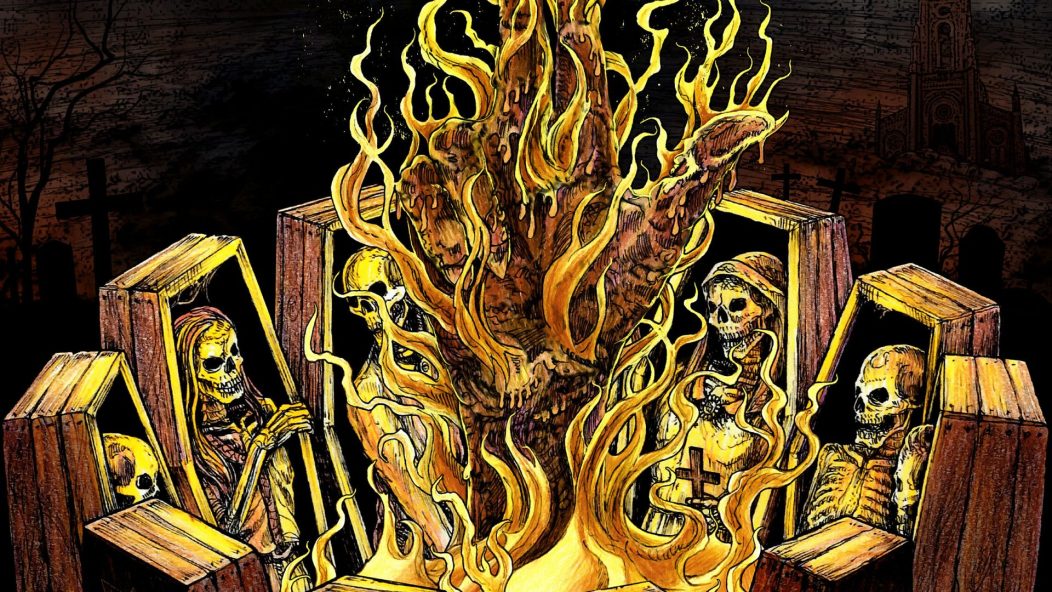
Coffins Unleash Gnarliest OSDM Album of the Year: Stream “Beyond the Circular Demise” Now

…
Formed in Tokyo in 1996, Coffins require no lengthy introduction; having achieved legendary status as one of Japan’s earliest and most enduring death metal entities, they continue to reign internationally as one of the genre’s most sinister names. Their discography contains over thirty distinct releases, featuring splits with a diverse and impressive roster of bands including Hooded Menace, Noothgrush, Ilsa, and so many more. Despite their storied history and vast range of collaborators, though, Coffins’ signature sound has remained anchored in the same classic blend of old-school extreme metal for over two decades. Stitching together the frenzied snarl of gory early 1990s OSDM and eerily plodding doom intonations, Coffins find no shame in continuing to perfect the vile, derelict strain of dungeon-crawling death-doom for which they are revered.
Though Coffins are known for constantly conjuring up new material, the release of a full-length album by the group is comparatively rare and infrequent, with multi-year gaps between each of their records. This year will stand as a hallowed year, then, for diehard fans of the group, as we see Friday’s release of their fifth full-length Beyond the Circular Demise on the horizon. As their second proper release under Relapse Records, the album will also be the first by the group to feature vocalist Jun Tokita and bassist Masafumi Atake, who joined in 2013 and 2015, respectively. Tenderizing those two slabs of fresh meat across six splits, two EPs, and a live album, Coffins have thoroughly revitalized and re-seasoned themselves in preparation for this savage new record. It is our pleasure to bring it to you in full below before Friday’s release.
…
…
Leaping back into volatile action, Beyond the Circular Demise sees Coffins picking up precisely where they left off in 2013 with yet another serving of their thorny, instantly recognizable mid-tempo death metal stew. Though the familiarity of the group’s musical approach is apparent in each of the album’s eight tracks, the work as a whole represents a subtle evolution in their music’s overall texture — this is evidenced by a more streamlined, holistically grimy iteration of their already subterranean sound. Also throughout Beyond the Circular Demise, Coffins emphasize the deepest, most unfiltered expressions of the lo-fi blasphemy created by their stylistic predecessors: tumultuous song structures and an erratic performance styles that reverentially nod to the jagged, thrash-soaked qualities of foundational old-school groups such as Possessed and early Death.
Like a torrent of cadavers, the album’s gnarled crunch assails the listener with incredible heft and physicality, but rarely claustrophobia. Unlike the meditative, astral portals rent asunder by more atmospheric death metal — even by transcendental groups popular within the OSDM revival we’re seeing today — Coffins aim to defile flesh and bone, not ravage the mind.
Eternally faithful to their well-tested recipe (consisting of a thick death metal broth with doom garnishes added for flavor), Beyond the Circular Demise bears witness to Coffins merging the two genres with tireless aplomb. By balancing this emulsion as to equip each track with a well-rounded fullness, the group allow a cohesive and perpetual flow across the record, with one composition flowing into the next seamlessly without ever repeating musical concepts outright.
Two distinct compositional techniques are utilized on the record: the first consists of a death metal structure that slowly descends into more derelict, doomy territory, as evidenced by tracks such as “Forgotten Cemetery” and “Hour of Extinction.” These tracks in particular brutalize the listener with a brisk and animalistic death metal assault that dismantles itself into slower and more ominous doom breakdowns. The second technique inverts this strategy by beginning with a death-doom premise that whips itself into a radically unhinged death metal frenzy before settling back into more doom-tinged patterns, as with “Impuritous Minds” and “The Tranquil End” — these monsters stomp along at a mid-tempo haul bolstered by the grooves of doomed sludge before incorporating their death metal decorations.
Despite this effective stylistic crossover, the vast majority of the record ultimately consists of what we’re comfortably just calling death metal. The only track that could be considered an even split between death and doom is the record’s nine-minute finale “Gateways to Dystopia,” a meandering, graven piece that enters into a more spiraling breakneck pace only toward its final moments. However, the combination of death metal’s gnawing tone and the slow breakdowning of doom utilized on Beyond the Circular Demise call to mind yet another class of metal: the slimy and groove-laden textures pure NOLA sludge infected with a decidedly inhuman growl. With their violent potency, the album’s raunchy, white-knuckled sludge rundowns are doubtlessly one of the record’s greatest strengths. This provides the listener with righteous, anthemic riffs, i.e. delicious payoff for the album’s more dizzying passages.
…

…
In terms of production, Beyond the Circular Demise operates by the now-widespread paradox of the nouveaux vintage sound popularized by first-wave death metal revivalism. Though its sound calls to mind the dingy crepuscular world of Tampa in 1991, it has awareness of 21st Century audiophilic refinement, coming across as the delightfully cavernous soundscape that those 1990s bands perhaps wished they could sound like, had the technology and/or money been in line at the time. Whatever the case, the increased presence of vocals and bass in the mix — and guitars/percussion that sound like chainsaws only because they are meant to — the effect is almost like a modern remastering of something dug up from an old mid-1990s demo.
The recent revival of OSDM by newly formed groups has only reinforced the timeless value of Coffins’ approach, and Beyond the Circular Demise shows that they were wise to never stray from the primal, essential roots of the genre. Because the band never ventured into more postmodern/experimental territory, its OSDM approach never made concessions to today’s modern sound. Now venturing back even further back into their own origins, Beyond the Circular Demise‘s bare-bones approach is staunchly straightforward and has a timeless, immortal potency. The band’s unswaying commitment to the same sound is incredible; it’s something which often goes unlauded or even criticized in some cases, but here, it nothing short of pure glory.
True, bands strictly unwilling to change become stale. That said, Beyond the Circular Demise is hardly repetitive or tedious, even for the most seasoned death metal historian. The cohesiveness of the album demonstrates moments of ingeniously economical yet thoughtful variations on the thrashing death metal structure. Though the album’s tone is messy and gory, the individual performances are never sloppy, but then again not surgically exact either — and, in this way, they are indeed perfect. Coffins isn’t trying to change anything about themselves or, at it seems, the direction of metal at large; above that, they aren’t even throwing back to anything because they actually came from then. This is just what Coffins sounds like, and nobody else can be Coffins.
The plain fact of Beyond the Circular Demise‘s infectious enjoyability is a testament to both Coffins’ songwriting ability and the timelessness of classic, always-unadulterated death metal.
…
Beyond the Circular Demise releases Friday via Relapse.
…
Support Invisible Oranges on Patreon and check out our merch.
…










